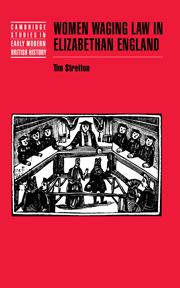Book contents
- Frontmatter
- Contents
- Lists of maps and figures
- List of tables
- Preface
- Notes on the text
- Abbreviations
- 1 Introduction
- 2 Women, legal rights and law courts
- 3 Female litigants and the culture of litigation
- 4 The Court of Requests
- 5 Unmarried women and widows
- 6 Married women in Requests
- 7 Freebench, custom and equity
- 8 Pleading strategies in Requests
- 9 Women waging law
- Glossary
- Bibliography
- Index
- Cambridge Studies in Early Modern British History
3 - Female litigants and the culture of litigation
Published online by Cambridge University Press: 11 November 2009
- Frontmatter
- Contents
- Lists of maps and figures
- List of tables
- Preface
- Notes on the text
- Abbreviations
- 1 Introduction
- 2 Women, legal rights and law courts
- 3 Female litigants and the culture of litigation
- 4 The Court of Requests
- 5 Unmarried women and widows
- 6 Married women in Requests
- 7 Freebench, custom and equity
- 8 Pleading strategies in Requests
- 9 Women waging law
- Glossary
- Bibliography
- Index
- Cambridge Studies in Early Modern British History
Summary
When Women goe to Law the Devill is full of Businesse
John Webster (1623)During the reign of Queen Elizabeth the proportions of women litigating in central jurisdictions fluctuated, rising in Chancery, falling in Common Pleas and Queen's Bench, and remaining fairly constant in Requests. But the physical numbers of women involved in litigation increased steadily. This meant more women travelling to London, more women staying in London for extended periods, and more women milling around Westminster, visiting attorneys, appearing as witnesses and presenting evidence on oath. Before examining the nature of women's involvement with the courts, the kinds of actions they brought, and the extent to which relatives, lawyers and other third parties influenced their legal dealings, it is helpful to consider the climate of opinion that surrounded women who contemplated going to law. How did different sections of society regard the idea of women possessing and exercising legal rights, and how did they react to the increase in the numbers of women going to court?
The sixteenth and seventeenth centuries witnessed a well-documented outpouring of writings on the subject of women. Contributors to the long running debate over female nature defended or attacked women's capabilities and character in works like The Scholehouse of Women, The Praise and Dispraise of Women and The Women's Sharp Revenge, reworking and reinforcing familiar stereotypes of the ‘bad’ woman and the ‘good’ woman as they went.
- Type
- Chapter
- Information
- Women Waging Law in Elizabethan England , pp. 43 - 69Publisher: Cambridge University PressPrint publication year: 1998

